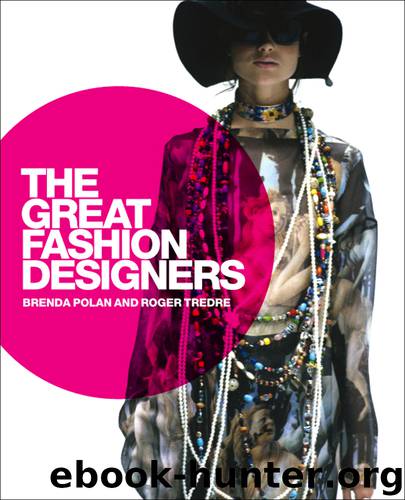The Great Fashion Designers by Brenda Polan

Author:Brenda Polan
Language: eng
Format: epub
Publisher: Berg Publishers
Published: 2009-08-28T04:00:00+00:00
the basic Valentino shape for day and evening as slender, except for a few bouffant dresses of calf or ankle length, as was the style of the early 1950s, before the mini. The surfaces of the slim, long evening dresses are encrusted with jewel embroidery and the narrow shapes are softened by back-flowing chiffon panels or capes. The day dresses are decorated with velvet bands or with a leopard-printed belt matched to an accompanying stole. They are accessorised with stiletto heels and small, forward-thrusting hats. We can see in this mini-collection the first appearance of Valentino’s red, the prominence of graphic black-and-white embroidery suggesting Meissen china and the black-and-white dress in a shape suggesting a Greek vase … Far more important, however, than any of these details is the unmistakeable sense of elegance and authority.
In 1957 Guy Laroche, the chief illustrator at Dessès, left to set up his own couture house, and Valentino went with him. Two years later, with financial backing from his father, Valentino presented his first collection in his own salon in the Via Condotti in Rome. Elizabeth Taylor, in Rome filming Cleopatra, ordered a white dress to wear for the world premiere of Spartacus—and the beautiful women of the world began to beat a path to his door. In 1960, Giancarlo Giammetti, a student of architecture, joined the young company, becoming Valentino’s partner and managing director; he was to run the business side until Valentino stepped down in 2007. In the same year, Valentino launched his ready-to-wear collection. He first showed with Giovanni Batista Giorgini’s stars at the Pitti Palace in Florence in 1962. At just thirty, he was allocated the last slot on the calendar, one that meant the buyers would have to stay another night, delaying their flights home. But they had heard rumours and they stayed. They raced backstage afterwards, elbows out and chequebooks at the ready. International recognition was within his grasp.
In the mid-1960s Valentino abandoned Florence and the Pitti group and, as the closing couturier of the Rome shows, crowned the presentations of the Fontana sisters, Princess Irene Galitzine, Maria Antonelli, Roberto Capucci and Emilio Schuberth. Valentino’s evening presentations became glittering social events in their own right, the audience composed of actresses and the wives of politicians, magnates and millionaires, all in evening wear and their best jewels. Perma-tanned and attended by a family of pugs, the couturier had become a member of the class he dressed, entertaining his clients socially in his many homes and on his yacht. His signature style was now established. Consistently elegant, it rarely changed direction suddenly but adhered to classic tenets of good taste while indulging in expensive detail and opulent decoration. These were clothes that looked rich but old-money rich, never vulgar, always glamorous, always grown-up. In 1968 he told Women’s Wear Daily, ‘I believe only in high fashion. I think a couturier must establish his style and stick to it. The mistake of many couturiers is that they try to change their line every collection.
Download
This site does not store any files on its server. We only index and link to content provided by other sites. Please contact the content providers to delete copyright contents if any and email us, we'll remove relevant links or contents immediately.
The Art of Boudoir Photography: How to Create Stunning Photographs of Women by Christa Meola(18535)
Red Sparrow by Jason Matthews(5389)
Harry Potter 02 & The Chamber Of Secrets (Illustrated) by J.K. Rowling(3620)
In a Sunburned Country by Bill Bryson(3481)
Drawing Cutting Edge Anatomy by Christopher Hart(3450)
Figure Drawing for Artists by Steve Huston(3375)
Harry Potter and the Prisoner of Azkaban (Book 3) by J. K. Rowling(3302)
The Daily Stoic by Holiday Ryan & Hanselman Stephen(3228)
Japanese Design by Patricia J. Graham(3107)
The Roots of Romanticism (Second Edition) by Berlin Isaiah Hardy Henry Gray John(2877)
Make Comics Like the Pros by Greg Pak(2850)
Stacked Decks by The Rotenberg Collection(2808)
Draw-A-Saurus by James Silvani(2652)
Harry Potter and the Deathly Hallows (7) by J.K. Rowling(2638)
Tattoo Art by Doralba Picerno(2599)
On Photography by Susan Sontag(2574)
Churchill by Paul Johnson(2505)
The Daily Stoic by Ryan Holiday & Stephen Hanselman(2454)
Drawing and Painting Birds by Tim Wootton(2436)
